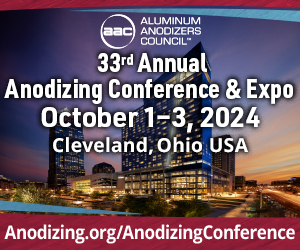The Problem of Sealing Smut
Is there an anodizing cleanliness standard that is reasonable for our suppliers to meet? Is there an ISO, ASTM, IPC, Nadac or any other standard?
Q. Is there an anodizing cleanliness standard that is reasonable for our suppliers to meet? Is there an ISO, ASTM, IPC, Nadac or any other standard? We are receiving aluminum anodized parts with too much powder or dust. We use the parts to enclose electronics. We then pot the unit but are concerned the excess contamination will prevent bonding. A.O.
A. Perhaps the best solution to your problem with sealing residue, or “smut,” on parts after being anodized and sealed is to specify to your anodizer that the parts must be clean and free of smut. You have the power to do this and you have every right to expect clean parts from the anodizer if this is what you require.
The U.S. standard document addressing this type of situation is MIL-A-8625. There are two or three areas in this spec that make reference to this. The first is paragraph 4.4.2, which states, in part: “The acceptance criteria shall be as specified in the contract or purchase order.” In paragraph 6.2, the topic is “Acquisition requirements,” which says that acquisition documents should specify the following, among other things, “Acceptance criteria for quality conformance inspections.” Paragraph 6.3, entitled “Painting/coating,” which includes adhesives, states in part: “Sealing processes can have a significant effect on adhesion of primers and other polymeric materials to the anodized surfaces as well as the cohesive strength of the anodized layer. If these factors are important to the application...specific details for the sealing process should be specified in the contract or purchase order.” Most anodized parts can be sealed without sealing residue or “smut” if the anodizer controls his process. Some high-silicon alloy parts will exhibit a “dusty” appearance after anodizing and sealing, but this is due primarily to the alloy properties and not to sealing smut per se.
One additional thought I have is that many sealing baths contain a significant amount of surfactants. These are used primarily to eliminate sealing smut. However, the presence of sealing smut on the parts does not mean that the sealing bath contains NO surfactants. Sometimes the presence of surfactants themselves can adversely affect the adhesion qualities of the anodic surface. If this is the case, your parts may best be sealed using only clean, high--quality deionized water. Your anodizer should know how to do this effectively.
Related Content
-
10 Anodizing Best Practices
Following this list of guidelines can help to increase the performance, cost effectiveness and quality for your anodizing operation.
-
Trivalent Chrome Overview
As the finishing industry begins to move away from the use of hexavalent chromium to trivalent chromium, what factors should finishers consider as they make new investments? Mark Schario, chief technology officer for Columbia Chemical offers a helpful overview of this complicated topic.
-
Products Finishing Reveals 2024 Qualifying Top Shops
PF reveals the qualifying shops in its annual Top Shops Benchmarking Survey — a program designed to offer shops insights into their overall performance in the industry.
















